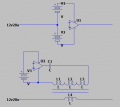Regarding the required power of 167 W: I understand that 167 W might seem high, but could you please clarify why you highlighted this figure and how it could pose a problem for my project?I have some issues with this element of the ongoing problem statement.
Firstly, white noise, by definition, is noise with constant power spectrum i.e. a flat frequency spectrum over the bandwidth in question. At a guess, one could argue for white noise into a specific resistive load, say 0.6ohm (being 12v @ 20A). Since V/√Hz = √(P/Hz x R), P/Hz = V/√Hz^2/R = .001 * .001/.6 = 1.666μW/Hz. Over a 100MHz bandwidth that's something like 167W if my math is right.
Secondly, top of the range lab supplies from the likes of Rigol, Agilent/Keysight, etc have a noise figure of 350uVrms over a 20MHz band width, roughly equivalent to 350/√20e6*√100e6 = 783uV√Hz, over 100MHz BW so roughly in the ballpark of your test signal - how are you going to isolate that?
On the noise levels of lab power supplies: Yes, I am aware that the noise levels of lab power supplies can be an issue. This is something I am actively working on. I am currently in contact with the people responsible for the noise specifications that we need to inject into the board to understand the origin of these noise levels and to explore potential solutions to improve the situation.






